
9 minute read
IDA HISTORY HIGHLIGHTS
In this two-part series, Dr. Jim Birkett, IDA Honorary Council Member and IDA Past President, reflects on the beginning of the desalination and advanced water treatment industry, and how IDA played a critical role in the global movement to enact sustainable water solutions. THE IDA GENEALOGY, PART 1 By Dr. Jim Birkett
IDA’s “Genealogy” Most members are probably aware that the International Desalination Association (IDA) was officially formed in the 1980s through the merger of the Water Supply Improvement Association (WSIA) and the International Desalination and Environmental Association (IDEA). But how did this come to pass? What is IDA’s ancestry? This paper summarizes the important points.
“In the Beginning….” Prior to 1985, there were three entities promoting conferences on desalination, to wit: The Working Party on Fresh Water from the Sea (WP), IDEA and NWSIA/WSIA. (The first named was a special committee organized periodically by the European Federation of Chemical Engineering to organize conferences on the subject matter.) Each of these groups had an interesting history of its own.
The Principal Entities The WP was organized as a result of the success of “The 1st European Symposium on Fresh Water from the Sea”, held in Athens in May/June of 1962 and sponsored by the European Federation of Chemical Engineering. Following the symposium, its organizers proposed the formation of a regular committee (the Working Party (WP)) to organize subsequent events. It met for the first time in Milan in 1965 and proposed that a “2nd Symposium on Fresh water from the Sea” be held in 1967, again in Athens. Subsequent conferences were held in Dubrovnik (1970), Heidelberg (1973), and Sardinia (1976), Gran Canaria (19??), and Amsterdam (1980). The principal individual coordinating all this was Professor Anthony Delyannis of the University of Athens. To this point the WP had acted independently of other organizations 1 . This
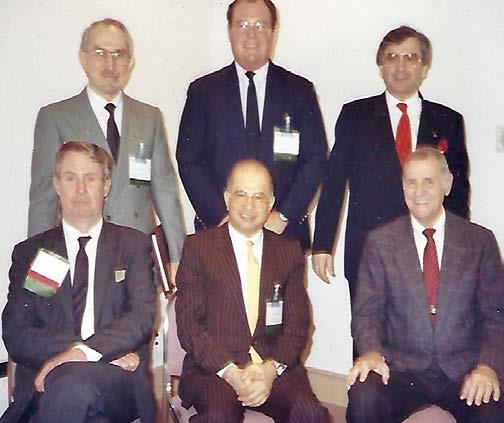
1993 IDA WC in Yokohama of five past-president plus the then current president (Jamil Al-Alawi, Bahrain, center). Front row - Jim Birkett, Jamil Al-Alawi, Floyd Meller / Back row - Adil Bushnak, Randy Truby, Leon Awerbuch
Evening at the Lido in Paris late 1982 or early 1983 where the various committees of IDEA, NWSIA, and the WC were working out the details of the joint "1st World Congress on Desalination and Water Reuse" in Florence in 1983. Working inwards from the left are: Abdul-Gaffar Jamjoon, Farouk Ghandour, Dr. Wolfgang Pusch (Chairman of the WC), Frau Schubl of DECHEMA (the German chemical engineering society), Bob Mattair (WSIA), guest, Leon Awerbuch, guest, Bill Hanbury and Kris Buros. Working inwards from the right are: a Saudi gentleman, Isam Jamjoon, guest, Herb Sliger, Pat Burke, Neil MacArthur, Jim Birkett and Nabil El-Ramly.
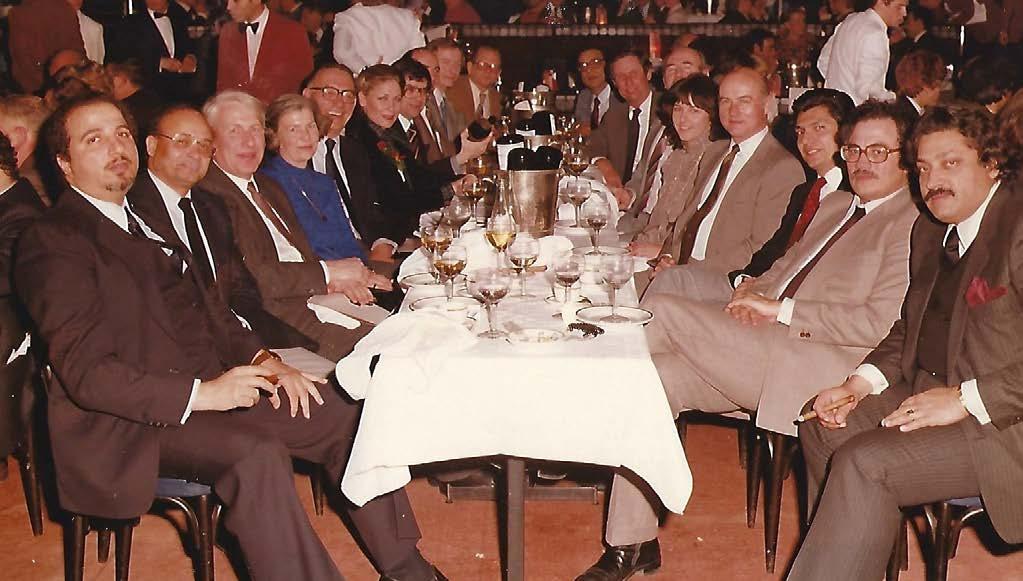
was about to change but we will pick up the WP thread again later in this article.
The IDEA developed from an earlier organization, the Association of Caribbean Desalination Plant Owners and Operators (ACDPOO), founded in 1973 at Grand Bahamas Island. Its purpose was “opening channels of communication between plant owners and operators……consultants and equipment manufacturers” 2 . The second meeting of the association was on Antigua in 1974 with increasing attendance. Because of the expansion of interest beyond the Caribbean, ACDPOO assumed a new name, the International Desalination and Environmental Association (IDEA). Its next meeting was held in Ponce, Puerto Rico, in 1975 with a further broadening of international attendance and interest. Subsequent conferences were held in Mexico City (1976), Tokyo (1977), Nice (1979 and Bahrain (1981). Throughout this period, the leading figure in the IDEA
54 Water Reuse Quarterly”, Vol. 4/1, pp 20-27 2 Bakish, R., “IDEA – “From its Beginning to 1984”, IDA Desalination & Water Reuse Quarterly, Vol. 3/4, pp 28-33
had been Dr. Robert Bakish of FairleighDickenson University. IDEA had also, up to now, operated independently of any other organization. This was about to change and we will pick up the IDEA thread later. The WSIA (originally named NWSIA) was formed as a result of budget changes at the Office of Saline Water (OSW), US Department of the Interior. The Office had been authorized by the US Congress in 1952 to fund research for the development of desalination technologies “to make the deserts bloom” and indeed had invested tens of millions of dollars by the early 1970s. However a new US administration decided to drastically cut its budget and the then Director of OSW, Pat O’Meara, organized a conference in Anaheim, California, in 1972 to study the challenges arising from such budget cuts. One result was the recommendation for creating a national desalting association to provide a focus of attention and to provide a vehicle for lobbying Congress to continue funding the desalination effort. Thus the National Water Supply Improvement Association (NWSIA) was formed in February of 1973, its constitution specifying three categories of membership. Division I included representatives of public entities, Division II included manufacturers, suppliers and major consulting firms and Division III included academics, researchers and other interested individuals. The Board of Directors was originally composed of six, two and three Directors from each division respectively. (This composition was intended to forestall dominance by commercial interests although the number of Division II members was eventually increased to six.) The first annual meeting and conference was held in Fort Lauderdale, Florida in June of 1973 and the first Directors and Officers elected. At that meeting the membership of NWSIA stood at 137. Subsequent conferences were held in Newport Beach, California, (1974), Ocean Reef, Florida (1975), Oklahoma City (1976) , San Diego (1977), Sarasota, Florida (1978), New Orleans, Louisiana (1979), San Francisco, California (1980) and Washington (1981). Attendance and membership increased apace as did the number of foreign participants. As a result the organization changed its name to the less restrictive Water Supply Improvement
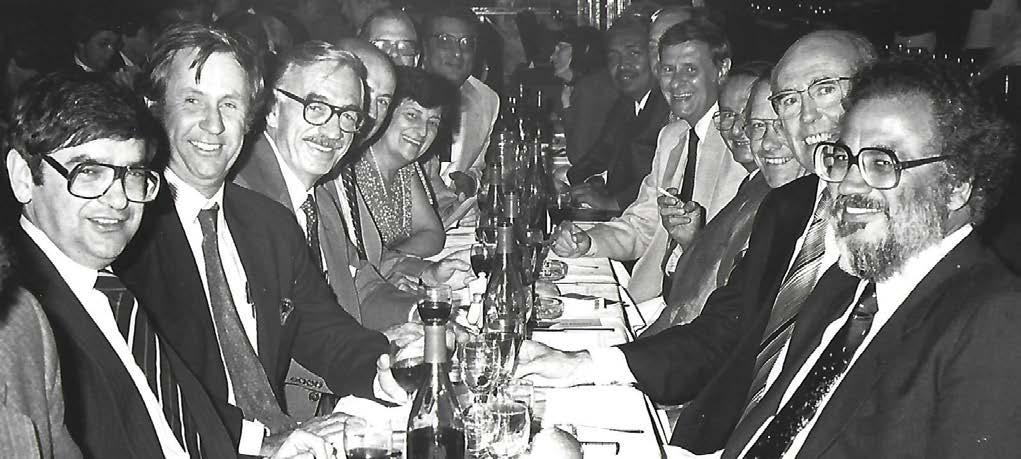
55 May 21, 1983 at the club Paradis Latin, following a day of IDEA/WSIA merger talks. Identifiable from the left are Leon Awerbuch, Jim Birkett, Bob Mattair, Herb Sliger, Miriam Balaban, Kris Buros and Nabil El-Ramily. At the end of the table sits Pat Burke. Identifiable from the right are H.E. Isam Jamjoon, Neil McArthur, Arther Harris, Jean-Jacque Libert (with his ever-present cigarette!) and Floyd Meller.
Association (WSIA). The 11th annual conference in Honolulu, Hawaii (1982) sported the new name plus the inclusion of a “Trade Fair” as a nod to the increasing number of exhibits. The guiding hand through the early years of NWSIA was that of William Warne. Also present was Patricia Burke, first simply as a representative of Avco Corporation but mostly as Conference Chairman and eventually Executive Director. For all of this period, WSIA had acted independently of other groups. Let us now bring them all togethe
The Delicate Minuet toward Merger
By the mid-1970s there was a proliferation of conferences covering desalination, not only those of the entities described above but other groups including AquaTech Amsterdam and various for-profit groups. Individuals from the major players began to talk to each other informally about ways to minimize or eliminate overlap. It was evident that some level of cooperation was better than outright competition. The first real example of the former was the “1st World Congress on Desalination and Water Reuse”, held in Florence in 1983. The WP and IDEA shared the technical organization and WSIA was responsible for the industry exhibition. Not only was the conference an overall success but for the first time all three groups worked together toward a common goal. The upshot was that a committee was formed, co-chaired by H.E. Isam Jamjoon (President of IDEA) and Herb Sliger (President of WSIA) and charged with presenting its recommendations for formal merger or any other option at the May, 1984, WSIA International Conference in Orlando, Florida. The committee met several times, including in Paris in the fall of 1983, and assigned Leon Awerbuch (WSIA) and Kris Buros (IDEA) the formidable task of writing a constitution describing a new organization of which all parties could approve. It soon became apparent that the WP did not fit into the mold of a conventional association. It had no members per se, only regular attendees at its conferences; on paper it consisted only of an organizing committee, periodically appointed. Yet its supporters were numerous and loyal. In the end the WP stepped away from the merger discussions yet remained open to cooperation opportunities in the future. Things came to a head at the Orlando WSIA conference in May of 1984. After several long and passionate meetings (one lasting until 3 am), the Boards of IDEA and WSIA and the “merger committee” finally reached agreement on an operating definition and constitution of a new organization to be known as The International Desalination Association (IDA). This was announced to the attendees at the Conference banquet. During the summer of 1984 all members of IDEA and WSIA had an opportunity to vote on the proposition. It was enthusiastically passed and on January 1, 1985, IDA officially came into existence. A “new” NWSIA was also formed as a regional affiliate After several long and passionate meetings (one lasting until 3 am), the Boards of IDEA and WSIA and the “merger committee” finally reached agreement on an operating definition and constitution of a new organization to be known as The International Desalination Association (IDA).
of IDA to accommodate former WSIA members who wished to maintain a national US focus. Floyd Meller and Neil McArthur, representing WSIA and IDEA respectively, were appointed as interim Co-Presidents until the first IDA conference in Bermuda in November, 1985. During the intervening summer, IDA’s first Board of Directors was nominated and elected by ballot. The first IDA Officers would be elected at the Bermuda conference and meeting. The Bermuda “2nd World Congress on Desalination and Water Reuse”, 1985, was organized by the nascent IDA and cosponsored by the WP. On that occasion IDA solidified its future administration through the election of its first slate of Officers and committee chairmanships. Dr. Jim Birkett, previously a Director of both IDEA and WSIA, was chosen as President, with Dr. Adil Bushnak as Vice President.
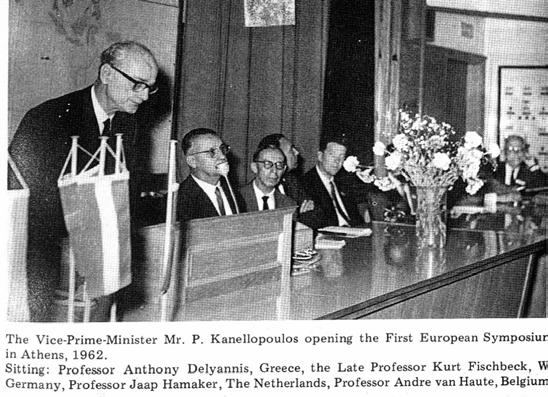
European Federation of Chemical EngineeringWorking Party on Fresh Water from the Sea. Initiated by Prof. Anthony Delyannis
Author’s Comments This article on the genealogy of IDA ends here. We intend to follow it up with further material on the early history of IDA, including more details of the original The above references fill in many details. In addition one might view back issues of The Water Desalination Report (Global Water Intelligence) which, from 1964 (?) onwards, reported weekly on activities in the desalination sphere. Although there are still a few of us left who participated during the pre-merger days, residual emotions and biases are such that it is doubtful that we could ever reach a consensus on how to sum things up. I have chosen instead to rely almost entirely on the above papers whose authors bear impeccable credentials. Regrettably, they are no longer available for interview.
About the Author
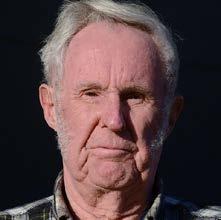
57 Dr. Birkett’s admirable career includes more than 50 years’ experience in the study of desalination, advanced water treatment, and membrane separation industries and technologies with Arthur D. Little and West Neck Strategies. He is a Past President and Director of IDA, recipient of the IDA Lifetime Achievement Award, and the former editor of “The IDA Journal on Desalination and Water Reuse.”










